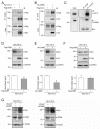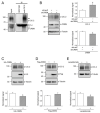CUL4-DDB1-CRBN E3 Ubiquitin Ligase Regulates Proteostasis of ClC-2 Chloride Channels: Implication for Aldosteronism and Leukodystrophy
- PMID: 32466489
- PMCID: PMC7348978
- DOI: 10.3390/cells9061332
CUL4-DDB1-CRBN E3 Ubiquitin Ligase Regulates Proteostasis of ClC-2 Chloride Channels: Implication for Aldosteronism and Leukodystrophy
Abstract
Voltage-gated ClC-2 channels are essential for chloride homeostasis. Complete knockout of mouse ClC-2 leads to testicular degeneration and neuronal myelin vacuolation. Gain-of-function and loss-of-function mutations in the ClC-2-encoding human CLCN2 gene are linked to the genetic diseases aldosteronism and leukodystrophy, respectively. The protein homeostasis (proteostasis) mechanism of ClC-2 is currently unclear. Here, we aimed to identify the molecular mechanism of endoplasmic reticulum-associated degradation of ClC-2, and to explore the pathophysiological significance of disease-associated anomalous ClC-2 proteostasis. In both heterologous expression system and native neuronal and testicular cells, ClC-2 is subject to significant regulation by cullin-RING E3 ligase-mediated polyubiquitination and proteasomal degradation. The cullin 4 (CUL4)-damage-specific DNA binding protein 1 (DDB1)-cereblon (CRBN) E3 ubiquitin ligase co-exists in the same complex with and promotes the degradation of ClC-2 channels. The CRBN-targeting immunomodulatory drug lenalidomide and the cullin E3 ligase inhibitor MLN4924 promotes and attenuates, respectively, proteasomal degradation of ClC-2. Analyses of disease-related ClC-2 mutants reveal that aldosteronism and leukodystrophy are associated with opposite alterations in ClC-2 proteostasis. Modifying CUL4 E3 ligase activity with lenalidomide and MLN4924 ameliorates disease-associated ClC-2 proteostasis abnormality. Our results highlight the significant role and therapeutic potential of CUL4 E3 ubiquitin ligase in regulating ClC-2 proteostasis.
Keywords: MG132; MLN4924; channelopathy; cullin E3 ubiquitin ligase; lenalidomide; polyubiquitination; proteasomal degradation.
Conflict of interest statement
The authors declare no competing financial interests.
Figures












Similar articles
-
Regulation of ClC-2 Chloride Channel Proteostasis by Molecular Chaperones: Correction of Leukodystrophy-Associated Defect.Int J Mol Sci. 2021 May 30;22(11):5859. doi: 10.3390/ijms22115859. Int J Mol Sci. 2021. PMID: 34070744 Free PMC article.
-
The Cullin 4A/B-DDB1-Cereblon E3 Ubiquitin Ligase Complex Mediates the Degradation of CLC-1 Chloride Channels.Sci Rep. 2015 May 29;5:10667. doi: 10.1038/srep10667. Sci Rep. 2015. PMID: 26021757 Free PMC article.
-
Ligand-mediated protein degradation reveals functional conservation among sequence variants of the CUL4-type E3 ligase substrate receptor cereblon.J Biol Chem. 2018 Apr 20;293(16):6187-6200. doi: 10.1074/jbc.M117.816868. Epub 2018 Feb 15. J Biol Chem. 2018. PMID: 29449372 Free PMC article.
-
Exploiting ubiquitin ligase cereblon as a target for small-molecule compounds in medicine and chemical biology.Cell Chem Biol. 2021 Jul 15;28(7):987-999. doi: 10.1016/j.chembiol.2021.04.012. Epub 2021 May 24. Cell Chem Biol. 2021. PMID: 34033753 Review.
-
Cullin-RING E3 Ubiquitin Ligases: Bridges to Destruction.Subcell Biochem. 2017;83:323-347. doi: 10.1007/978-3-319-46503-6_12. Subcell Biochem. 2017. PMID: 28271482 Free PMC article. Review.
Cited by
-
CRBN modulates synuclein fibrillation via degradation of DNAJB1 in mouse model of Parkinson disease.NPJ Parkinsons Dis. 2024 Oct 23;10(1):194. doi: 10.1038/s41531-024-00801-3. NPJ Parkinsons Dis. 2024. PMID: 39443520 Free PMC article.
-
Regulation of ClC-2 Chloride Channel Proteostasis by Molecular Chaperones: Correction of Leukodystrophy-Associated Defect.Int J Mol Sci. 2021 May 30;22(11):5859. doi: 10.3390/ijms22115859. Int J Mol Sci. 2021. PMID: 34070744 Free PMC article.
-
Pin1 promotes human CaV2.1 channel polyubiquitination by RNF138: pathophysiological implication for episodic ataxia type 2.Cell Commun Signal. 2024 Nov 28;22(1):571. doi: 10.1186/s12964-024-01960-9. Cell Commun Signal. 2024. PMID: 39609819 Free PMC article.
-
Stress-induced reduction of Na+/H+ exchanger isoform 1 promotes maladaptation of neuroplasticity and exacerbates depressive behaviors.Sci Adv. 2022 Nov 11;8(45):eadd7063. doi: 10.1126/sciadv.add7063. Epub 2022 Nov 11. Sci Adv. 2022. PMID: 36367929 Free PMC article.
-
Regulation of testosterone synthesis in Leydig cells by ClC-2 chloride channel.Reproduction. 2025 Jul 18;170(2):e240432. doi: 10.1530/REP-24-0432. Print 2025 Aug 1. Reproduction. 2025. PMID: 40683311 Free PMC article.
References
Publication types
MeSH terms
Substances
Grants and funding
LinkOut - more resources
Full Text Sources
Medical
Molecular Biology Databases
Research Materials

